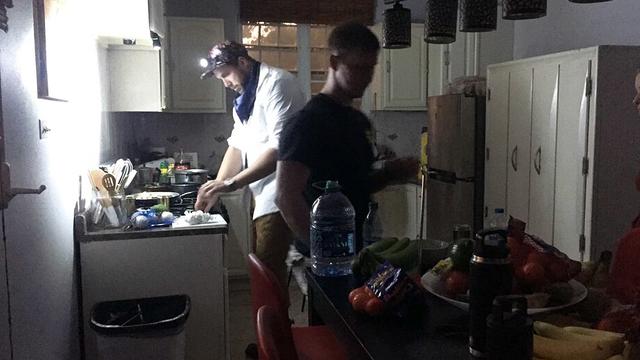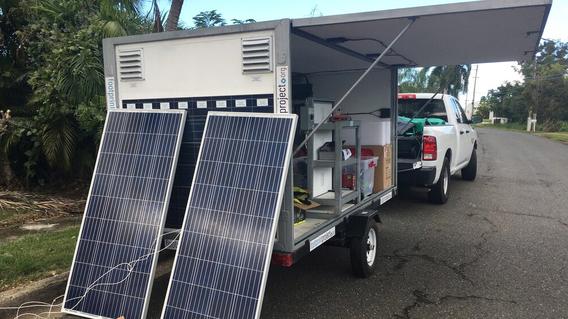A group of University of Minnesota faculty and students spent the past few weeks in Puerto Rico to study the island’s post-hurricane energy infrastructure—and then the earthquakes began.
This new disaster upended their schedule, but gave them an unexpected and deeply impactful experience that they say provides a greater understanding of the challenges faced by the residents of Puerto Rico.
The group of 10 students, seven of whom are from the Humphrey School, went to Puerto Rico as part of the University’s Global Convergence Lab. This is the second year of the lab, which brings faculty and students from the University of Minnesota together with counterparts from the University of Puerto Rico to explore different types of energy systems that could withstand future natural disasters.
They began their trip by meeting with researchers, members of nonprofits, and community members to discuss their research project. But just a few days after they arrived, the island was struck by a series of earthquakes, several strong enough to cause significant damage.
In one of several blog posts about the trip, Humphrey School students Lauren Fisher and Shannon Evans Engstrom described the experience as unsettling.
We arrived in Mayagüez on January 6 and awoke around 4:30 a.m. the next day to the largest earthquake in Puerto Rico since 1918. It was recorded as a magnitude 6.4 earthquake, which caused the power to go out across the island. Another 5.6 magnitude quake hit at 7:18 a.m. The earthquakes and aftershocks in the southwest of Puerto Rico continued for days...
We are studying energy resiliency while also learning what energy resiliency means in real time. We are experiencing the uncertainty of vital infrastructure, like energy and water, becoming unreliable. Our electricity and water have gone out multiple times for long stretches without warning. It has been a surreal and unsettling experience for us...
This week has provided a unique yet challenging opportunity for engagement and relationship building with our project partners and community groups...
Our group is still processing our experience in Puerto Rico. But we feel certain that living through these uncertain conditions will change the way each of us approach our work into the future. We will take with us a new understanding of the challenges Puerto Ricans face.
Four of the students stayed in the earthquake zone for a few days, along with Assistant Professor of Architecture Jacob Mans, and helped with relief efforts. Because the research team had developed relationships with non-governmental organizations and community members beginning a year ago, Mans says the group was able to step in and help out for a few days without getting in the way.
They worked with a Minneapolis-based nonprofit called the Footprint Project to supply portable solar generators to areas that lost power.
In this blog post, College of Design student Ebtehal Bahnasy describes that effort.
Members of the Footprint Project were already in Puerto Rico, with a solar charging station ready to be moved where it was needed...
On January 8, they joined us in Mayagüez where members of our group helped them finalize some cable connections and pack the needed solar equipment. The next day, we all headed to our project’s location in Aguadilla... [a school and community center that will also serve as a 'resiliency hub' in case of disasters.]
[We helped set up the solar equipment and a charging station] ... and people expressed relief. Communication is one of the main issues following disasters. The station generates 1.5 K watts, which can charge up to 100 cell phones. Refrigerators are also needed to store insulin for diabetes patients. The station also has a battery that can store power to be used at night or when it is cloudy...
One day later, the power was back to Aguadilla. The charging station was moved to Yauco, where about 2,000 people were staying in the stadium with no power, afraid to go back home.
In addition, Mans said the group went to a nearby Walmart store each day to buy supplies, with funding provided by the UMN School of Architecture, and distribute them in the communities they visited.
“It was a pretty dramatic thing for the students. They were in the midst of watching communities trying to organize relief efforts, and seeing firsthand people losing their homes, getting injured,” said Mans. “There’s been a ton of stress because of the cluster of earthquakes, they kept on happening, and there was no way of knowing when the next one was going to hit.”
The situation was challenging for Mans and Humphrey School Assistant Professor Gabe Chan, who were the faculty leaders of the trip.
“We needed to figure out how to balance our desire to push students out of their comfort zone with our responsibility to take care of them and make sure they’re safe,” said Chan. “It’s a scenario that we had no idea we were walking into.”
Chan said these two weeks spent in challenging circumstances highlight the urgency and importance of their work to develop resilient energy systems for disaster-prone areas.
“We’re studying sustainable infrastructure, and we lived with the power going out, with water service going out. We were impacted, not to any degree as the people we partner with who live in Puerto Rico, but we better understand what vulnerable infrastructure means,” Chan said. “We’re all still processing this experience, but having gone through it, we were all changed.”



